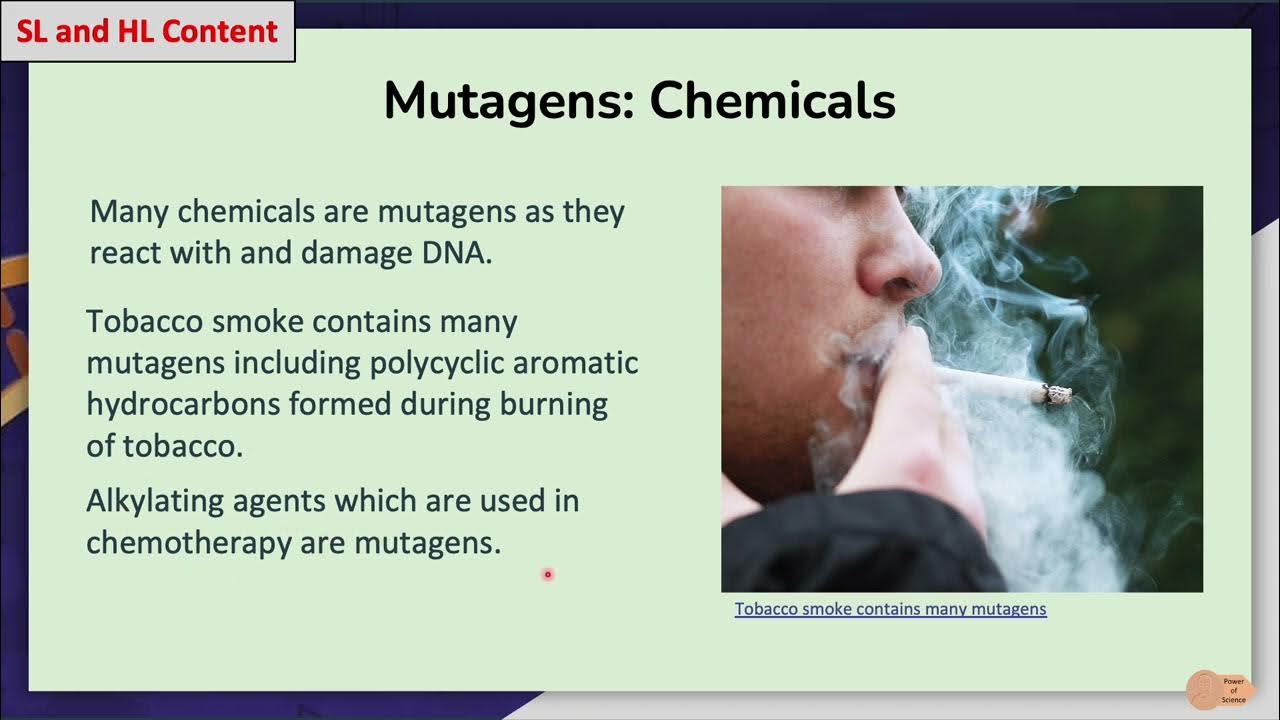GCSE Biology - What are DNA Mutations? #67
Summary
TLDRThis educational video delves into DNA mutations, explaining how changes in the DNA sequence can occur spontaneously or be triggered by carcinogens and radiation. It outlines the structure of genes and proteins, highlighting how a mutation can alter an amino acid sequence, potentially affecting protein shape and function. The video also touches on non-coding DNA's role in gene expression and distinguishes between three types of mutations: substitutions, insertions, and deletions, emphasizing their varying impacts on genetic code and protein synthesis.
Takeaways
- 🧬 **Mutation Defined**: A mutation is a change in the DNA base sequence, such as a C changing to a G.
- 🌐 **Spontaneous Mutation**: Mutations naturally occur in cells, especially during DNA replication before cell division.
- 🚭 **Carcinogens and Radiation**: Exposure to harmful chemicals like those in cigarette smoke and certain types of radiation can increase the risk of mutations.
- 🔍 **Not All Exposures Cause Mutations**: While carcinogens and radiation increase risk, they do not guarantee mutations will occur.
- 🧬 **DNA and Genes**: A gene is a section of DNA that codes for a protein, with each group of three bases (codon) coding for an amino acid.
- 🔄 **Protein Synthesis**: The sequence of codons determines the sequence of amino acids that fold to form a protein.
- ⚠️ **Impact of Mutations**: A mutation can alter the amino acid sequence, potentially changing the protein's shape or function.
- 🔄 **Enzyme Function**: If a protein is an enzyme, a mutation might affect its active site, preventing it from catalyzing reactions.
- 🌀 **Most Mutations Are Harmless**: Many mutations have little effect because they only slightly alter proteins or occur in non-coding DNA.
- 🧬 **Non-Coding DNA**: Non-coding DNA does not code for proteins and its function is not fully understood, but some plays a role in gene expression.
- 🔑 **Gene Expression**: Genes can be turned on or off, like the hemoglobin gene in nerve cells which is not expressed.
- 🔄 **Types of Mutations**: There are three main types of mutations - substitutions, insertions, and deletions - each affecting the DNA sequence differently.
Q & A
What is a mutation?
-A mutation is a change in the DNA base sequence, which can alter the letters that make up the DNA code. This can occur spontaneously or due to certain external factors.
What are some factors that increase the risk of mutations?
-Two main factors that increase the risk of mutations are carcinogens, such as those found in cigarette smoke, and certain types of radiation, including x-rays and gamma rays.
What is a gene, and how does it relate to proteins?
-A gene is a section of DNA that codes for a protein. It does so by using sequences of bases (called codons or triplets) that correspond to amino acids, which are the building blocks of proteins.
How can a mutation in a gene affect the protein it codes for?
-A mutation can change the sequence of amino acids that make up a protein, potentially altering its shape or function. For example, if the protein is an enzyme, the mutation might prevent it from binding to its substrate, making it unable to catalyze a reaction.
Do all mutations have significant effects on the body?
-No, most mutations do not have significant effects. Many mutations only slightly alter the protein or occur in non-coding DNA, which doesn’t directly affect gene expression.
What is non-coding DNA, and why is it important?
-Non-coding DNA is DNA that doesn't code for proteins. While much of it has no known function, some of it plays a crucial role in regulating gene expression, controlling whether certain genes are turned on or off.
What are the three main types of mutations?
-The three main types of mutations are substitutions, insertions, and deletions. Each type involves different changes to the DNA sequence and can affect proteins in various ways.
What happens in a substitution mutation?
-In a substitution mutation, one base in the DNA sequence is replaced with another, which can result in a different amino acid being coded, potentially altering the protein.
How does an insertion mutation differ from a substitution mutation?
-In an insertion mutation, an extra base is added to the DNA sequence, which shifts all subsequent bases and codons. This can result in a more dramatic change in the amino acid sequence and protein structure than a substitution mutation.
What occurs in a deletion mutation?
-In a deletion mutation, a base is removed from the DNA sequence, causing all subsequent bases and codons to shift, similar to an insertion. This can greatly alter the amino acid chain and the resulting protein.
Outlines

This section is available to paid users only. Please upgrade to access this part.
Upgrade NowMindmap

This section is available to paid users only. Please upgrade to access this part.
Upgrade NowKeywords

This section is available to paid users only. Please upgrade to access this part.
Upgrade NowHighlights

This section is available to paid users only. Please upgrade to access this part.
Upgrade NowTranscripts

This section is available to paid users only. Please upgrade to access this part.
Upgrade NowBrowse More Related Video

51. Mutations

Summary of Gene Mutations

Mutations et variabilité génétique - 1ère spé SVT - Madame SVT

Aula Biologia - Mutações Gênicas - Origens e Consequências para o Enem e Vestibulares - STOODI

L'ADN et les informations génétiques - SVT Seconde - Les Bons Profs

An introduction to genetic mutations | Biomolecules | MCAT | Khan Academy
5.0 / 5 (0 votes)